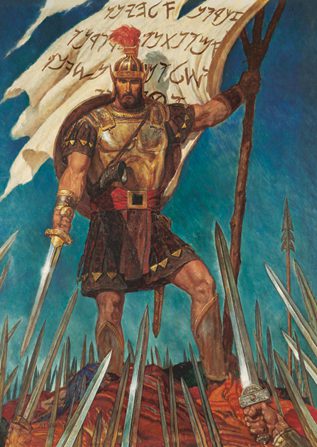
(Arnold Friberg, LDS Media Library)
I’ve located the source that Joseph Smith used to create his fictional “Captain Moroni.”
But, first, a little background:
Ernst Gombrich (Sir Ernst Hans Josef Gombrich, 1909-2001) was a very famous Austrian-born art historian who fled the Nazis to Britain in 1939, became a naturalized British subject in 1947, and spent most of his career at the prestigious Warburg Institute in London.
When he was still in his twenties, though, he wrote Eine kurze Weltgeschichte für junge Leser — A Brief History of the World for Young Readers.
I had never heard of this book until I found it in a Swiss bookstore a short while ago, but I’ve lately been reading a bit in it every night before bed.
And it was last night that I made my stunning discovery.
I was reading about Greek resistance to the expansion of the Persian empire in the early fifth century BC — leading up, first, to the famous battle of Marathon — when I came upon these two sentences:
“Die Athener hatten einen Feldherrn mit Namen Miltiades, einen mutigen, gescheiten Mann, der lange unter den Persern gelebt hatte und ihre Art zu kämpfen genau kannte. Und alle Athener wußten, worum es ging: um ihre Freiheit, um ihr Leben, um das ihrer Frauen und Kinder.”
“The Athenians had a field commander by the name of Miltiades, a courageous and clever man who had lived for a long time among the Persians and who was well acquainted with their manner of fighting. And all of the Athenians understood what this was about: It was about their freedom, their lives, and the lives of their wives and children.”
I immediately recognized the affinities of this passage to the Book of Mormon’s description of “Captain Moroni.”
First of all, it’s not difficult to see that the names Miltiades and Moroni are essentially the same: Simply replace -iltiades with -oroni while maintaining the initial M- and there’s no difference at all. (This phenomenon is common in linguistics: Replace the -ook of book with -ible, for instance, and the result is Bible — the Book. Take the word baseball, replace the interior -e- with the infix -ket-, and you have basketball.)
Moreover, their military offices are identical: Miltiades was the Athenian “Feldherr” or “field commander” and “Moroni” was “the chief captain over the Nephites” (Alma 43:16).
But to proceed:
The occurrence of the essentially identical names Miltiades and Moroni is an important clue, of course, as is their identical position as Feldherr/field commander/captain. That, however, is just the beginning.
Miltiades, for instance, is described as “courageous and clever.” Similarly, “Moroni” is famous for his stratagems. (See Alma 43:16-30;
In the story of “Moroni,” the goal of the Lamanite leader Zerahemnah is to “gain power over the Nephites by bringing them into bondage” (Alma 43:8). And this was definitely the goal of the Persian king Darius I.
By contrast, the Athenians were only seeking to defend “their freedom, their lives, and the lives of their wives and children.”
This is the clincher.
“The design of the Nephites was to support their lands, and their houses, and their wives, and their children, that they might preserve them from the hands of their enemies; and also that they might preserve their rights and their privileges, yea, and also their liberty, that they might worship God according to their desires.” (Alma 43:9)
“It was the only desire of the Nephites to preserve their lands, and their liberty, and their church.” (Alma 43:30)
“They were not fighting for monarchy nor power but they were fighting for their homes and their liberties, their wives and their children, and their all, yea, for their rites of worship and their church.” (Alma 43:45)
“They cried with one voice unto the Lord their God, for their liberty and their freedom from bondage.” (Alma 43:49)
And, later on, when Moroni rends his coat and hoists it upon a pole as the famous “title of liberty,” he writes the following on it: “In memory of our God, our religion, and freedom, and our peace, our wives, and our children.” In other words, as Ernst Gombrich writes about the battle of Marathon, “It was about their freedom, their lives, and the lives of their wives and children.”
Plainly, Ernst Gombrich’s Eine kurze Weltgeschichte für junge Leser is the source that Joseph Smith used in order to forge his Book of Mormon.
A few minor problems — but only a few — remain. For example, Eine kurze Weltgeschichte für junge Leser was first published in 1935. Some diehards will insist that this is too late for the book to have influenced Joseph Smith, who was murdered in 1844 and who published his Book of Mormon in 1830. I will leave it to other scholars to deal with this frivolous objection.
And some will point out that Joseph Smith doesn’t appear to have known German in the late 1820s or early 1830s and that Ernst Gombrich’s Eine kurze Weltgeschichte für junge Leser wasn’t published in English until Yale University Press issued it in 2008 as A Little History of the World.
But such trivial and desperate arguments are easily disposed of. Three decades ago, for example, two intrepid researchers suggested that the cosmological ideas in the Book of Abraham derive from Joseph Smith’s “information environment,” which they defined by using a 1728 entry in Benjamin Franklin’s unpublished personal papers as well as an obscure 1755 work by the German philosopher Immanuel Kant that was barely noticed in Germany and wasn’t published in English until 1900.










